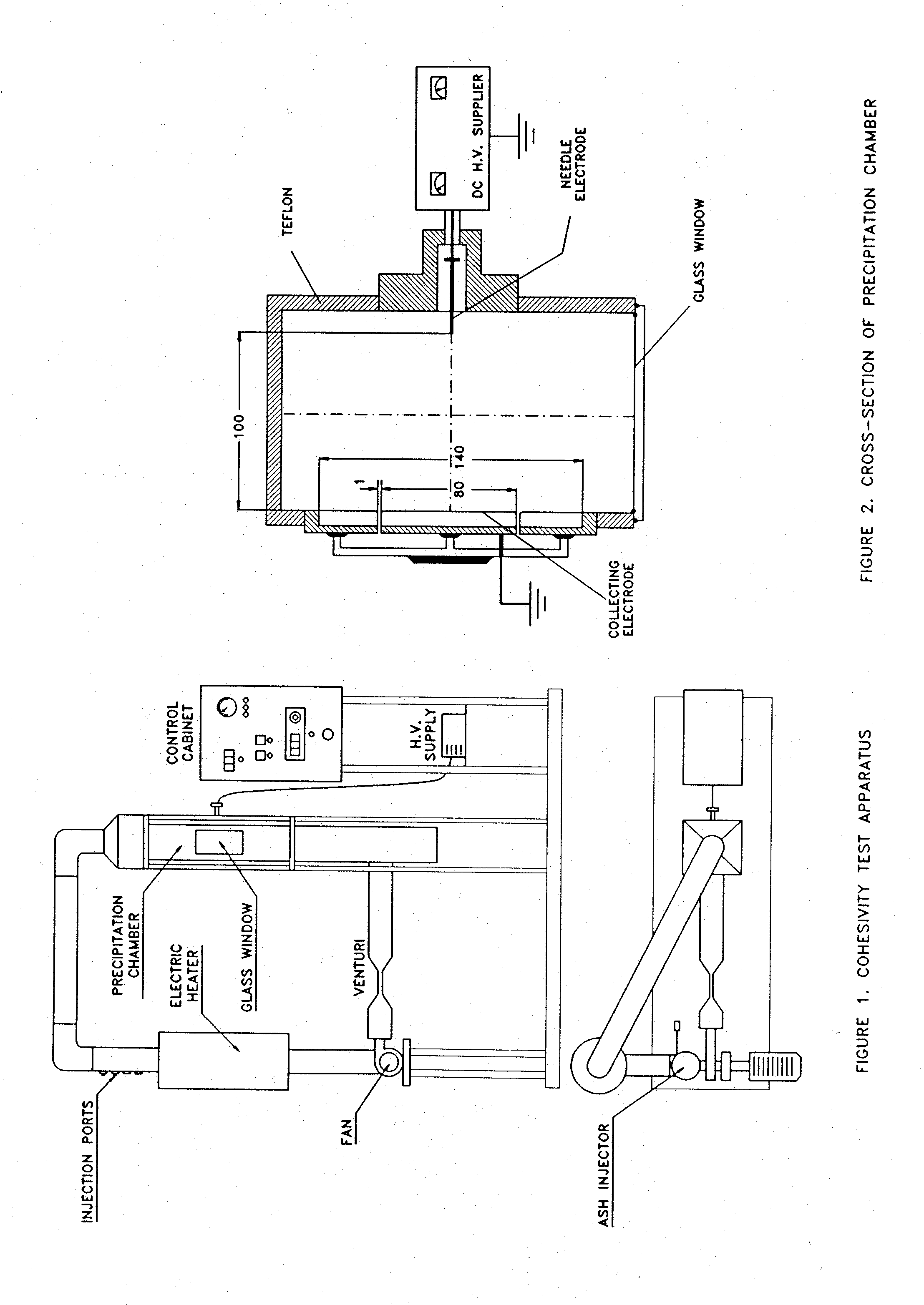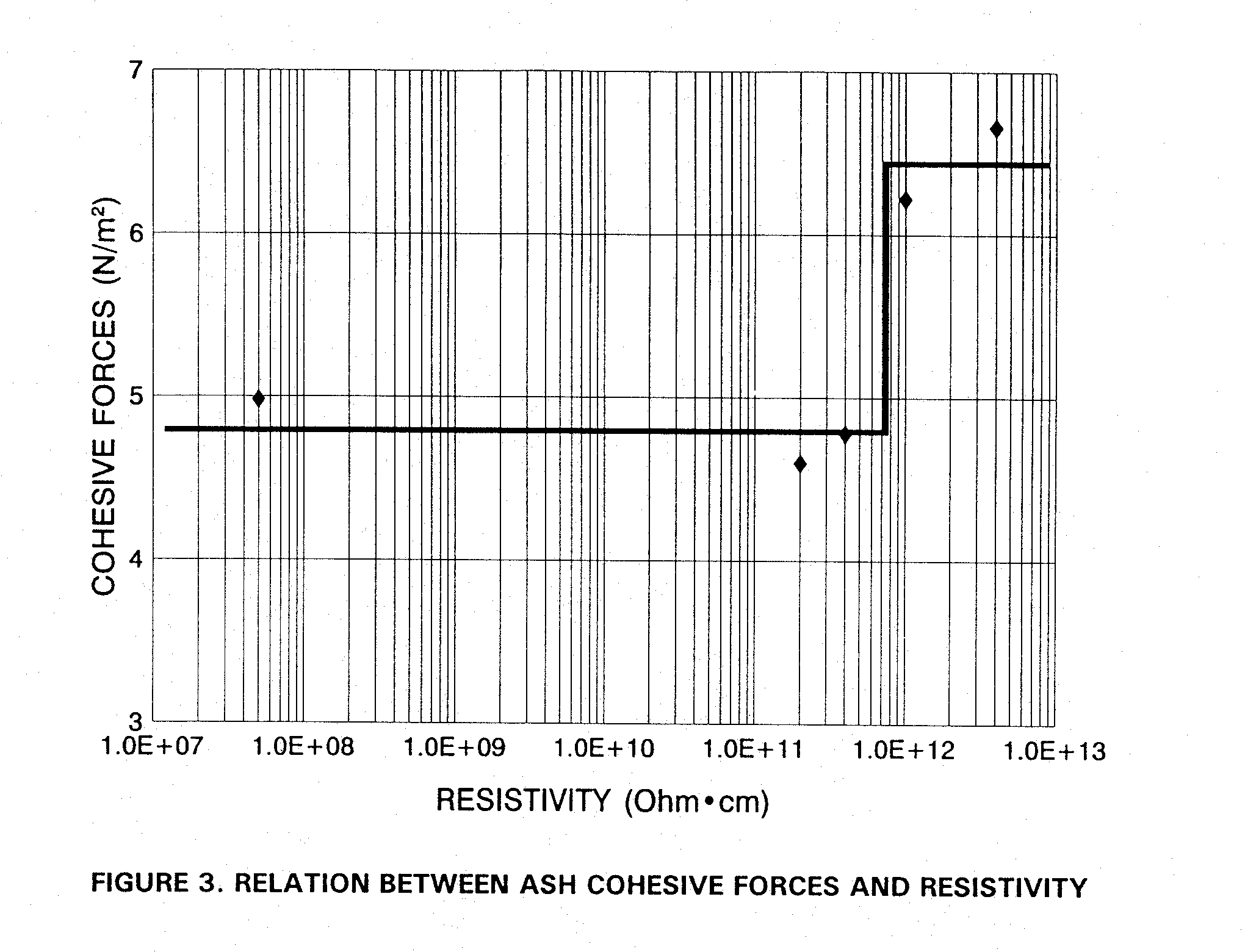| Back to |
RELATIONS BETWEEN COAL/FLY ASH
PROPERTIES AND COHESIVEFORCES IN ELECTROSTATICALLY PRECIPITATED
ASH LAYERS
L. Canadas, B. Navarrete,. L. Salvador
Dept. Ingenieria Quimica y Ambiental. E.S.I.I. - Universidad de Sevilla
Avd. Reina Mercedes, s/n. 41012-SEVILLA (SPAIN)
Abstract
The main results of a research program directed to the investigation of fly ash cohesiveness and adherence to ESP plates and their relation with coal and ash properties are presented.
A total of 58 coal and fly ash samples coming from 6 pc boilers have been extensively characterized by means of standard and non-standard analyses to identify physical, chemical, morphological, mineralogical, and ESP performance related characteristics, like resistivity and dust layer adherence to the collecting plates. A measuring method of cohesive forces on electrostatically precipitated fly ash and a test apparatus have been developed. The ash cohesion under approximate real conditions in industrial ESPs has been measured. Correlation's between the cohesive force and the coal/fly ash characteristics have been established, and also the relation with ash resistivity.
Introduction
The primary characteristic of fly ash which is generally included in specifications for electrical precipitators for coal-fired boilers is the content of various minerals in the particles. Together with the additional information included in the Coal Classification Code such as moisture and sulfur content, mineral content enables prediction of the electrical resistivity of the fly ash particles suspended in the flue gas when the boiler type and operating conditions are properly considered. Additionally, fly ash characteristic specifications usually include information about the expected particle size distribution of the fly ash.
Although it is recognized that, in some cases, particles cohesiveness and adhesiveness may require special attention in the electrostatic precipitator design, these characteristics are not included in standard fly ash specifications. Currently, the lack of such specifications may, in practice, be Justified since the rapping devices incorporated in modem fly ash electrostatic, precipitators are generally enough efficient to secure that dust layers are maintained with an even distribution and acceptable thickness over the entire collecting plate surface. It is well known, however, that fly ash produced from some Australian and South African coals, can exhibit strong cohesiveness which gives rise to a thick, uneven dust layer on the collecting plates, and thus seriously impedes electrostatic precipitator performance. Similar characteristics have been observed for fly ash from coals mined and burned in Puertollano, Spain.
Under this perspective, development and implementation of measuring methods to quantify cohesiveness and adhesiveness of collected fly ash would be beneficial. Likewise, obtaining the correlation between cohesiveness and coal characteristics would also be worthwhile so that the need for special design precautions could be identified in the planning stage. These objectives aimed the research project which is presented in this paper whose main intention was to establish the background for an extension of existing Coal Characterization Codes with respect to the ash adherence to ESP collecting plates and the cohesiveness of the fly ash particles.
Experimental PlanThe research work has included the following tasks:
Measuring Method for Ash Cohesive Forces
The forces that keep compacted an ESP dust layer have different origins. The whole of them
is known as cohesive force, and it is made up of. Van der Waals forces, capillarity
forces, forces due to solid bridges between particles, and electrical forces. The cohesive
force mainly depends on the nature of particulate matter, its granular composition,
surface characteristics, and the compacting and internal structure of the layer. The
environmental conditions where the la er is formed are decisive in its genesis and hence,
in its physical properties.
In order to reproduce the influence of the environment in the cohesiveness measurement, a laboratory apparatus has been developed in which the layer is built up in a small electrostatic precipitator, where the charge, migration, and deposition of ash particles is reproduced. The fly ash cohesion grade can be measured on this layer by means of the tensile strength evaluated from the ash effusion voltage, according with the method proposed by Pontius et al. [1]. Also the thickness of the stable layer can be measured as a result of cohesive and adhesive forces in the layer.
Due to the small quantity of ash that is normally available from the fly ash samples, a small point-to-plane based apparatus was chosen to be the most suitable laboratory corona chamber to be developed. The apparatus was aimed to fulfil the following requirements:
The test apparatus was designed on a closed circuit arrangement, as shown in the Figure 1, including the following significant elements: corona chamber; high voltage DC supply; piping system, with injection points of H
2O, fly ash, and additives; electric heater with a thermostat for temperature control; variable speed fan and venturi flow meter for flow control; a controlled fly ash injection device; and a rapping system.The precipitation chamber geometry was selected in order to work under maximum uniformity of current density on the collecting electrode taking into account the theoretical approximation to this system. The geometric dispostion of the point-to-plane system can be seen in Figure 2. The collecting area is formed by a central disc, of radius R
1 = 40 mm, and a esternal ring of radius R2 = 70 mm. They are separated by an annular free space of 1mm. This reometry tries to avoid the edge effects of the electric field and maintains the uniformity of the current density in the central disc which is used as the base for the cohesiveness measurements. The discharge electrode is formed by a needle placed a distance S = 100 mm from the collecting electrode.The working conditions of the test apparatus simulate the conditions present in a real scale ESP. The working gas used is hot humidified air and the magnitudes that can be controlled are: gas temperature (up to 150OC), gas moisture, flow velocity (up to 1.5 m/s), fly ash loading, and electric field (up to 6 kV/cm).
The cohesiveness test consists of two stages:
1. Fly ash layer formation on the capture electrode.
After the apparatus is closed and sealed, the gas is
heated up to operation temperature.
Fly ash is periodically injected into the circulating
gas stream. The gas conditions are maintained.
And the fly ash is electrostatically precipitated.
2. Ash cohesion measusrement.
After the layer formation, the gas into the apparatus
is cooled down to ambient temperature. The point discharge
electrode is exchanged for a plane electrode, and the
cohesive forces measurement is accomplished following the
Pontius' tensiometer procedure which consists of
increasing the negative voltage in the plane electrode up to ash
particles jump from the layer. This value of
voltage is the effusion voltage (V

where T is the cohesive force (tensile strength) and h is the interellectrode distance.

Basic fly ash characteristics
Global data to identify main fly ash characteristics are presented in Table 1. As it can be seen all the tested fly ash belong to ASTM Class F, and show some important differences in porosity, particle size, minerals -content, and in-situ ash resistivity. Also cohesive forces measured according the developed method are presented in Table 1.
Relations between coal/fly ash properties
In order to define the relations of cohesive forces with other coal and fly ash characteristics, correlation's has been sought between coal chemical composition, ash properties, and measured cohesive forces of ash layers. This search has been accomplished by a multivariable regression technique using cohesive force as dependent variable against the rest of properties determined in chemical, physical, and special analyses of samples.Due to the uncertainty about the independent variables that could be the most significative, a stepwise regression model has been chosen. This model works as a pure multivariable analysis, but it is possible to put in or take out modelling variables at every step of the execution, depending of its significance in the resultant regression. The statistical base to accept a variable requires that the global indicator of correlation adjustment be higher than the value of the F-Snedecor distribution function for the corresponding degrees of freedom and the desired trust level (a=0,05).
The statistical method have only found positive regressions with two variables: the Na
2O content in the fly ash and, with a lower significance, with the ash equivalent diameter. When more variables are forced to enter in these two correlation's, the stepwise model only accepts the SO3 content in the fly ash as an additional variable to the regression with Na2O content, and no improvement was produced in the correlation with ash equivalent diameter. Other relevant properties, like ash porosity which has been related in other research works with ash cohesion, do not present correlation or its significance is very low to be taken into account. Also, it has to be pointed out that no regression with any coal property was obtained. Therefore the resulting statistical correlation's can not be used as a predictive method to estimate ash cohesiveness.The best obtained correlation is as follows:
Fc = 7.85 - 2.97 (Na
2O) - 0.63 (SO3)where Fc is the cohesive force in N/m
2 (measured by means of the tension meter method applied to electrostatically precipitated ash layers), Na2O is the ash sodium content as obtained from the ash elemental analysis by Atomic Absorption, and SO3 is the ash sulfates content, both expressed in weight percentage. This correlation achieves a coefficient of determination (R2) of 0.93.The same statistical method was applied using the measured dust layer thickness as independent variable. In this case, the regressions present very low coefficients of determination and any kind of dependence can not be significatively concluded.
To completely understand the meaning of obtained results it should be taken into account that the results of the used method are strictly limited to those relations between variables that can be mathematically expressed by means of a polynomial equation. This implies that any other existing qualitative or complex relation is not identified by the method.
The variables included in the final regression are generally considered as very important parameters in relation with ash behavior in ESPs. In this sense, ash surface enrichment on sulfates has been proven to be related with ash agglomeration, and both sodium and sulfates content in the ash have a substantial influence on fly ash resistivity in the same direction indicated by cohesive forces regression. Therefore, it becomes apparent that ash resistivity should be related to ash cohesiveness, although no regression has been found by statistical models. Figure 3 shows this relation. Evidently there is not possible to obtain a mathematical correlation between the two properties but a threshold in ash resistivity seems to exists at about 10" Ohm-cm, and ashes with a higher resistivity should be very cohesive.

Concluding remarks
A device to measure fly ash cohesive forces on electrostatically precipitated dust layers has been developed. The used measuring principle is to determine the effusion voltage according to the method proposed by Pontius. Ash cohesiveness has been related with standard and nonstandard coal and fly ash properties by means of an extensive statistical study. As main results, a regression equation using ash sodium and sulfates contents as independent variables has been obtained as the only significative mathematical predictive relation for cohesive forces measured on electrostatically precipitated ash layers. No correlation with coal properties has been found. Only a weak relation between ash particle size and cohesive forces is obtained. And the dependence of ash cohesion with ash resistivity has been documented, the higher cohesive forces being linked to resistivity values higher than a threshold of 10
12 Ohm.cm.Acknowledgments
This paper is based in the work performed in the Phase 3B of the CARE research program. The program was financed jointly by the European Coal and Steel Community (ECSC), Cia. Sevillana de Electricidad (Spain), and FLS Miljo Environmental Management (Denmark).
References
1 .